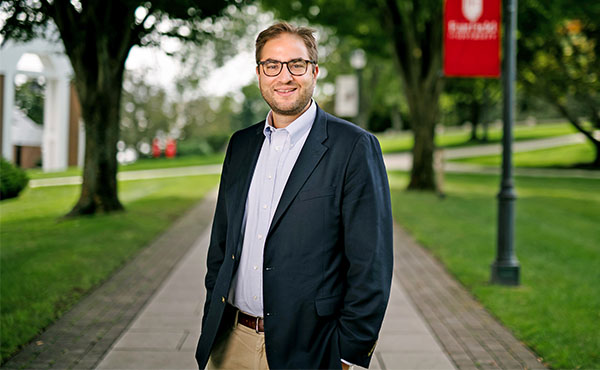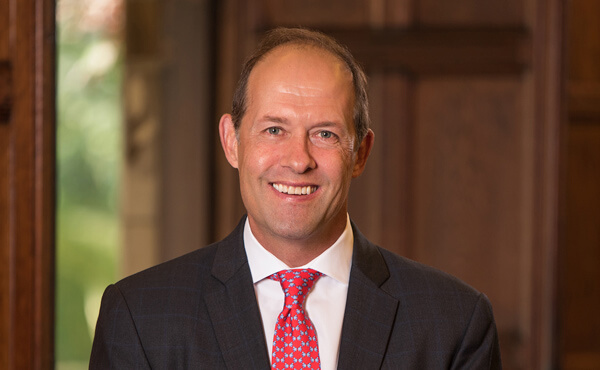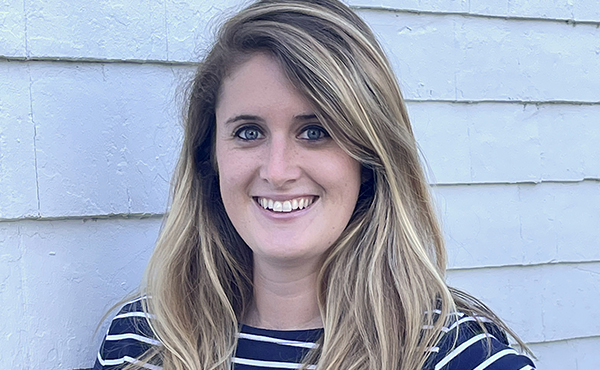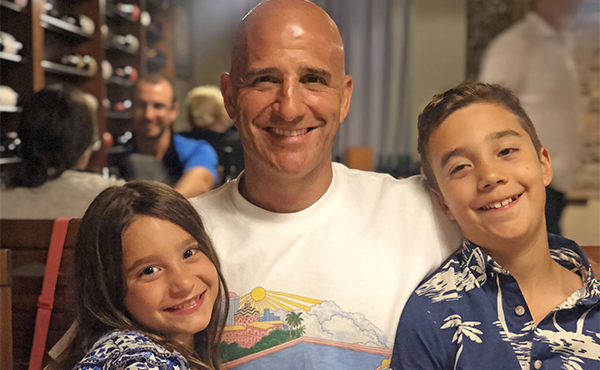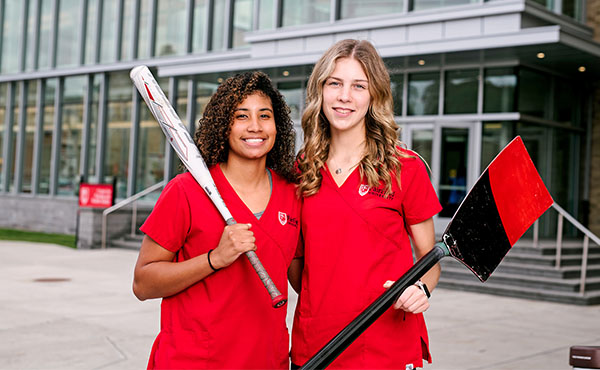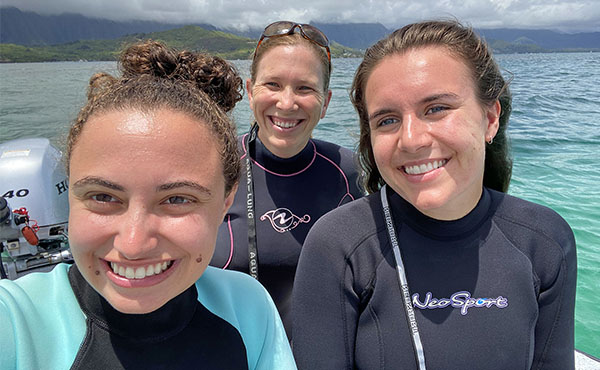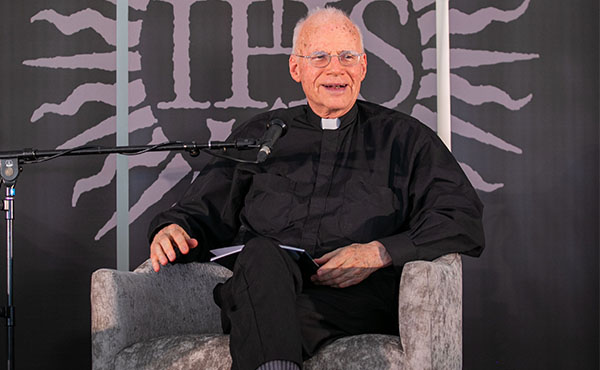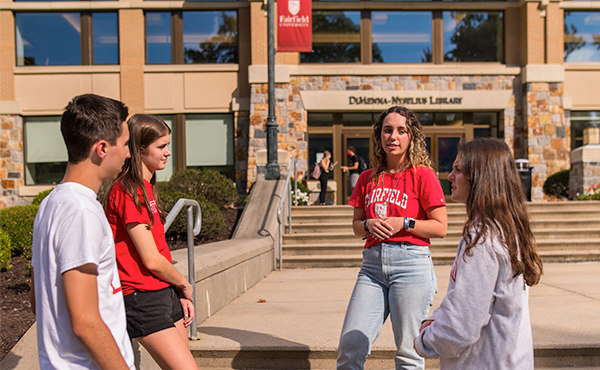Fairfield’s VP for Strategic Enrollment Management Corry Unis on the Big Data Approach to Admission.
We want Fairfield to reflect the world in which we live, and that should be an important goal for any enrollment office.
— Corry Unis, Vice President for Enrollment Management
For many colleges and universities, maintaining student enrollments has become a very real challenge. And yet at a time when higher education is experiencing the largest college enrollment decline in a decade, Fairfield University has continued to defy the odds. Under the leadership of Vice President for Strategic Enrollment Management Corry Unis, the University has experienced record-breaking enrollment growth over the past four years, welcoming its second largest undergraduate class during the peak of the pandemic, and its largest and academically strongest class this past fall.
Combining the art of relationship building with the science of data analytics, Unis and his team are setting an example of how the right people and the right science can make all the difference.
Fairfield University Magazine: Since starting your position at Fairfield in 2018, you and your team have been credited with revolutionizing the University’s enrollment process using “big data.” Can you explain how that works?
Corry Unis: There are tens of thousands of high schools in the country. So when we think about where we want to grow our student count and cultivate the next generation of Fairfield students, we have to identify pockets of 20 or 30 schools in a specific metro area or zone that we know have students who are willing to travel out of state, have an affinity towards Jesuit or Catholic higher education, and have the potential to be academically successful. So from a 30,000-foot view, we use predictive analytics to help determine what that list of schools should be.
We also use data to better understand our applicants. Because we are an outcomesfocused University, we model and assign modeling scores to students based on their predicted first-year GPA and graduation rate. So when we admit, we’re admitting with the intent of retaining and graduating. Predictive analytics can also help us gauge a student’s interest in the University and how likely they are to enroll if admitted. That data can then help us determine how many classes to offer in a semester, as well as predict the size and scope of the incoming class.
The past four years have yielded the largest undergraduate enrollment numbers in University history. To what do you contribute this level of success?
As far as how we’ve achieved success in an era where head counts are shrinking and demographics are shifting, I think there are a few contributing factors. The first is that we have a very strong enrollment team that believes in aggregate that the world is a better place with more Fairfield graduates.
Second, I think the University’s trajectory is ripe for enrollment success. Whether it’s our new academic programs, our strong marketing and communications presence, or the infrastructure of the University as a whole, our trajectory has been a great boost in assisting with our enrollment goals.
Third, I believe that predictive modeling has really helped us refine our audience and identify prospective students that we wouldn’t have had the opportunity to identify before. It’s also helped us increase selectivity and our student profile. And while I’m proud of what our team has achieved in terms of class head count and our student profile, I’m even prouder that our students have been retaining at record numbers and that graduation rates continue to increase.
Another major area of focus for your enrollment team has been increasing the diversity of Fairfield’s student population. What are the key components of a successful diversity recruitment strategy?
We want Fairfield to reflect the world in which we live, and that should be an important goal for any enrollment office. We have a team that’s very focused on outreach to traditionally underrepresented students and who understands the importance of radical hospitality as a tenet of recruitment and relationship building. We want to meet students where they are, and make sure they feel welcome, invited, and called to be here.
One of the newer initiatives we’ve launched is The Company Scholars program. Developed in partnership with the Offices of Advancement and Student Life, this cohortstyle program will attract 10 to 15 traditionally underrepresented students to campus each year by removing the financial burden of a college education and offering four year, fulltuition scholarships to low-income students attending Jesuit and Cristo Rey high schools (a group of 38 Catholic preparatory schools for low-income students). In addition to the academic component of the program, there is a leadership element and a mentorship piece, all of which is being offered in a cohort style that makes us very confident the students will retain well and graduate in four years. We’re very excited to see this initiative take shape.
University President Mark R. Nemec, PhD, recently referred to the announcement of The Company Scholars and the University’s “Pathways to Higher Learning” partnership with the Diocese of Bridgeport as “major steps toward increased educational access at a critical moment in our society.” How important are programs like these in today’s higher education landscape?
Pathway programs are incredibly important. Not only do they help breakdown the barriers that underrepresented students face when pursing higher education, but they empower students by giving them the confidence, skills, and vision to achieve their aspirations.
Because of the foresight of our administration and the strength of the University’s footprint, I think Fairfield is very poised to take on a leadership role within our community. Our expanded partnership with the diocese will help underserved populations achieve an education that might otherwise be unattainable.
What does the future of Fairfield’s enrollment look like in the next 3-5 years?
Even though we welcomed the University’s largest class this fall, we still feel that there’s a little bit of an opportunity to grow at the undergraduate level, and we are definitely planning for significant growth at the graduate level.
As far as some of the challenges we’re going to face, there is the issue of affordability, as well as the impeding demographic cliff in 2026, when the number of high school graduates flatlines and then falls into decline. But like any year, our main challenges will be finding the right group of students who we know can be successful at Fairfield, diversifying that population, and then diversifying it in terms of geography. Fairfield has done a nice job in recent years of growing our number of students from the Boston metro area, Pennsylvania, D.C., Maryland, and Virginia. We would like to continue seeing some steady growth from those areas, as well as areas in Chicago, California, and Florida, where we have several zones of influence and know we can bring in great and capable students.
